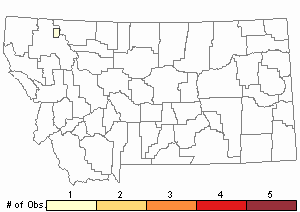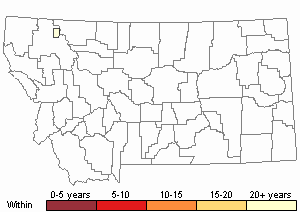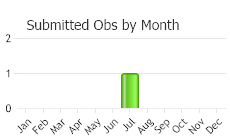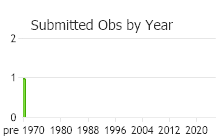View in other NatureServe Network Field Guides
NatureServe
Montana
Utah
Wyoming
Idaho
Wisconsin
British Columbia
South Carolina
Yukon
California
New York
Luminous Moss - Schistostega pennata
Other Names:
Cave Moss, Goblet Gold
Native Species
Global Rank:
G4
State Rank:
SU
(see State Rank Reason below)
Agency Status
USFWS:
USFS:
BLM:
External Links
State Rank Reason (see State Rank above)
Distribution data in BIOTICS had Distribution Confidence as "Reported but unconfirmed" with no explanatory notes. FNA 2014 does show this species in Montana.
General Description
Plant: Loose mats or tufts. Olivaceous to brown to black, sometimes with yellowish tones. Stems 1.2-12 cm tall. Central strand of stem in X-S is weak or absent.
Leaf: When dry, leaf is erect or curved, rarely (falcate-) secound. Leaf ovate-lanceolate to ligulate, sharply keeled distally, and 1.3-3.2 mm long. Margins recurved from base to apex or to just below the apex. Margins denticulate distally. Apex acute to sub-obtuse. Costa percurrent or excurrent as an awn. Awn smooth or faintly denticulate, usually papillose on abaxial side, and sometimes decurrent.
Leaf Cells: Basal laminal cells near margin are usually quadrate. Median to upper laminal cells are usually short-rectangular, smooth, sinuose, and 8-10 µm wide.
Phenology
Capsules mature from late spring to early summer.
Diagnostic Characteristics
Protonema is persistent and its cells can reflect light, giving off a green-golden color. Look-alikes include the species of Fissidens that also occur on mineral soil. Large cell leaves easily seen with hand lens.
Range Comments
Estimated range greater than 1,000,000 square miles worldwide. Circumboreal but with highly irregular distribution. North America (northern US, Canada), UK, Scandinavia, Europe, Russia, Japan. FNA (2007) more specifically mentions for Canada: AB, BC, NB, NL, NS, ON, QC; and for the USA: AK, ID, ME, MI, MN, MT, NH, NY, OH, OR, RI, VT, WA, WI. Known in Montana from Flathead County (Elliott 2016).
Observations in Montana Natural Heritage Program Database
Number of Observations: 1
(Click on the following maps and charts to see full sized version)
Map Help and Descriptions
Relative Density

Recency


 (Observations spanning multiple months or years are excluded from time charts)
(Observations spanning multiple months or years are excluded from time charts)
Habitat
Mineral soil in crevices on the lower, sheltered areas of upturned tree root wads or on cave ceilings, crevices in soil banks, and in animal burrows. Rarely found on the shaded area of deep pits along the upper banks of a perennial stream. Occasionally found on rock. Occurs from low to high elevations (near sea level to 5,600 feet) (FNA 2007).
Reproductive Characteristics
Autoicous. Capsules are dark red or brown, and short-cylindric, 0.7-1.3 mm long.
Stewardship Responsibility
References
- Literature Cited AboveLegend:
 View Online Publication
View Online Publication Elliott, J.C. and A.K. Pipp. 2018. A Checklist of Montana Mosses (1880-2018). Updated 3 January, 2020. Montana Natural Heritage Program, Helena, Montana. 73 pp.
Elliott, J.C. and A.K. Pipp. 2018. A Checklist of Montana Mosses (1880-2018). Updated 3 January, 2020. Montana Natural Heritage Program, Helena, Montana. 73 pp. Flora of North America Editorial Committee, eds. 2007. Flora of North America North of Mexico. Volume 27. Bryophytes: Mosses, Part 1. Oxford University Press, Inc., NY. xxi + 713 pp.
Flora of North America Editorial Committee, eds. 2007. Flora of North America North of Mexico. Volume 27. Bryophytes: Mosses, Part 1. Oxford University Press, Inc., NY. xxi + 713 pp.
- Additional ReferencesLegend:
 View Online Publication
View Online Publication
Do you know of a citation we're missing? Elliot, J. C. 1993. Second checklist of Montana mosses. Unpublished report. U.S. Forest Service, Region 1. Missoula, MT. 45 pp.
Elliot, J. C. 1993. Second checklist of Montana mosses. Unpublished report. U.S. Forest Service, Region 1. Missoula, MT. 45 pp. Lawton, E. 1971. Keys for the Identification of the Mosses on the Pacific Northwest. Reprinted from 'Moss Flora of the Pacific Northwest'. Published as Supplement No. 2 of the Journal of the Hattori Botanical Laboratory. Nichinan, Miyazaki, Japan. 66 pp.
Lawton, E. 1971. Keys for the Identification of the Mosses on the Pacific Northwest. Reprinted from 'Moss Flora of the Pacific Northwest'. Published as Supplement No. 2 of the Journal of the Hattori Botanical Laboratory. Nichinan, Miyazaki, Japan. 66 pp. Lawton, E. 1971. Moss Flora of the Pacific Northwest. Hattori Botanical Laboratory. Japan: Yamabuki-cho, Shinjuku-ku, Tokyo. 362 pages plus appendices.
Lawton, E. 1971. Moss Flora of the Pacific Northwest. Hattori Botanical Laboratory. Japan: Yamabuki-cho, Shinjuku-ku, Tokyo. 362 pages plus appendices.
- Web Search Engines for Articles on "Luminous Moss"





